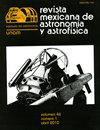两个k光谱型接触双星系统的光度分析
IF 1.7
4区 物理与天体物理
Q3 ASTRONOMY & ASTROPHYSICS
Revista Mexicana de Astronomia y Astrofisica
Pub Date : 2022-10-01
DOI:10.22201/ia.01851101p.2022.58.02.06
引用次数: 1
摘要
首次用Wilson—Devinney程序分析了接触双星ROTSE J135349.8+305205(CB1)和1SWASP J150957.5-115308(CB2)的光曲线。两个二元系统都是A亚型,填充浅(分别为20.8%和15.8%),组分之间的温差小于200 K。CB1的质量比为0.302,而CB2的质量比则为0.904。短周期,CB1为0.246d,CB2为0.229d,以及它们的光谱类型K表明这些系统接近最短周期极限。使用GAIA视差来估计绝对元素。CB2被发现处于进化的开始,而CB1将接近最后的进化阶段。CB1的组成质量之和为0.813 M☉, 低于1.0−1.2 M的质量极限☉ 假设是已知的接触双星。本文章由计算机程序翻译,如有差异,请以英文原文为准。
PHOTOMETRIC ANALYSIS OF TWO K SPECTRAL TYPE CONTACT BINARY SYSTEMS
The first analysis of the light curves of contact binaries ROTSE J135349.8+305205 (CB1) and 1SWASP J150957.5-115308 (CB2) using the Wilson-Devinney code is presented. Both binary systems are of the A-subtype with a shallow fill-out (20.8% and 15.8% respectively) and a difference in temperatures between the components of < 200 K. A mass-ratio of 0.302 is found for CB1, while for CB2 the interesting value of 0.904 is found. The short periods, 0.246 d for CB1 and 0.229 d for CB2, and their spectral type K suggests that these systems are near the shortest period limit. The absolute elements are estimated using GAIA parallaxes. CB2 is found to be at the beginning of its evolution, while CB1 will approach the final evolutionary stage. The sum of the component masses of CB1 is 0.813 M☉, below the mass limit of 1.0 − 1.2 M☉ assumed for the known contact binary stars.
求助全文
通过发布文献求助,成功后即可免费获取论文全文。
去求助
来源期刊

Revista Mexicana de Astronomia y Astrofisica
地学天文-天文与天体物理
CiteScore
1.30
自引率
10.00%
发文量
14
审稿时长
>12 weeks
期刊介绍:
The Revista Mexicana de Astronomía y Astrofísica, founded in 1974, publishes original research papers in all branches of astronomy, astrophysics and closely related fields. Two numbers per year are issued and are distributed free of charge to all institutions engaged in the fields covered by the RMxAA.
 求助内容:
求助内容: 应助结果提醒方式:
应助结果提醒方式:


